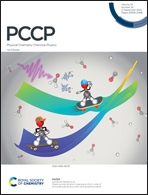Prediction of a novel 2D porous boron nitride material with excellent electronic, optical and catalytic properties†
Abstract
Holey graphyne (HGY) is a recently synthesized two-dimensional semiconducting allotrope of carbon composed of a regular pattern of six- and eight-vertex carbon rings. In this study, based on first-principles density functional theory and molecular dynamics simulations, we predict a similar stable porous boron nitride holey graphyne-like structure that we call BN-holey-graphyne (BN-HGY). The dynamical and thermal stability of the structure at room temperature is confirmed by performing calculations of the phonon dispersion relations, and also ab initio molecular dynamics simulations. The BN-HGY structure has a wide direct band gap of 5.18 eV, which can be controllably tuned by substituting carbon, aluminum, silicon, and phosphorus atoms in place of sp and sp2 hybridized boron and nitrogen atoms of BN-HGY. We have also calculated the optical properties of the HGY and BN-HGY structures for the first time and found that the optical absorption spectra of these structures span the full visible region and a wide range of the ultraviolet region. We found that the Gibbs free energy of the BN-HGY structure for the hydrogen adsorption process is very close to zero (−0.04 eV) and, therefore, the BN-HGY structure can be utilized as a potential catalyst for the HER. Therefore, we propose that the boron nitride analog of holey graphyne can be synthesized, and it has a wide range of applications in nanoelectronics, optoelectronics, spintronics, ultraviolet lasers, and solar cell devices.



 Please wait while we load your content...
Please wait while we load your content...